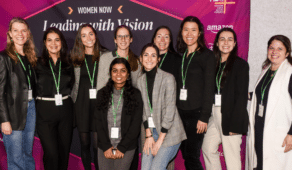This article originally appeared on Greenbook
It felt like not long ago, most conversations about AI and automation revolved around fear. Fear of robots displacing human jobs. Fear of a future where humans are no longer the best at chess, Go, or Jeopardy. Fear of, as said best by Elon Musk, “a fleet of artificial intelligence-enhanced robots capable of destroying mankind.”
However, this sentiment towards machines seems to have shifted as of late. We’re starting to view machines as our faithful servants rather than our oppressive overlords. We’re imagining a future where we can catch-up on our favorite shows on Netflix (custom curated by a machine of course) while being chauffeured to work in our self-driving cars. An AI-driven future more aligned with another billionaire’s perspective:
“We can look forward to the idea that vacations will be longer at some point. If we can actually produce twice as much as we make today with less labor, the purpose of humanity is not just to sit behind a counter and sell things. More free time is not a terrible thing.”
– Bill Gates
In Programmatic Advertising
It’s a beautiful future Bill Gates conjures up. A future with increasing productivity, automation of joyless dull tasks, and longer vacations. The wonderful thing is that this future is already here for many industries. In my own career in programmatic advertising, this harmonious union of man and machine has completely taken over.
With simple inputs about a customer’s business goals and just a few clicks in my ad buying platform, I can set up a complex media campaign that takes billions of data points and algorithmically converges at the ideal optimization decision in mere seconds.
It’s hard to imagine a situation where manual targeting and handpicked optimizations would ever beat out the machine, so why try? In the programmatic advertising world, we’ve learned to team up with our robot friends and it’s paying dividends.
In Market Research and Insights
This partnership between man and machine is also beginning to impact the market research and insights world. Traditional market research, particularly quant research, usually begins with data organized by human statisticians. However, the world has changed, and the amount of data available is just too massive for humans and their antiquated analytic tools to even begin to process. AI and machine learning must be employed to process and distill the mountain of data into something that humans can understand.
This marriage of human and machine can be especially powerful in the generation of consumer and market segmentation studies. The method for understanding a brand’s consumer segments – using offline datasets measuring reported behavior derived from surveys and focus groups – has gone unchanged for years, almost decades.
With the overabundance of event-level observational consumer data now available from mobile devices, doesn’t it just make sense to let the machines do a lot of the heavy lifting? Let the machines take care of the clustering, organizing, distillation of data, so we can do what we do best – using our intuition and domain expertise to extract deep human insights and ultimately provide real value to our customers.
A Love Story for the Ages
New use cases are emerging every day where the marriage of man and machine are yielding superhuman productivity and efficiency. Even the seemingly non-automatable situations – like identifying PTSD in veterans, or identifying cancer and diseases in cells – are rising to unimaginable levels of accuracy due to the help of our robotic friends. Once this partnership is seen as commonplace, we can look forward to a much-needed evolution in the market research and insights space. In a world where automation has freed so many, insights professionals and researchers can be empowered to focus on what really matters: extracting profound insights for their clients and – let’s not forget – taking longer vacations.

